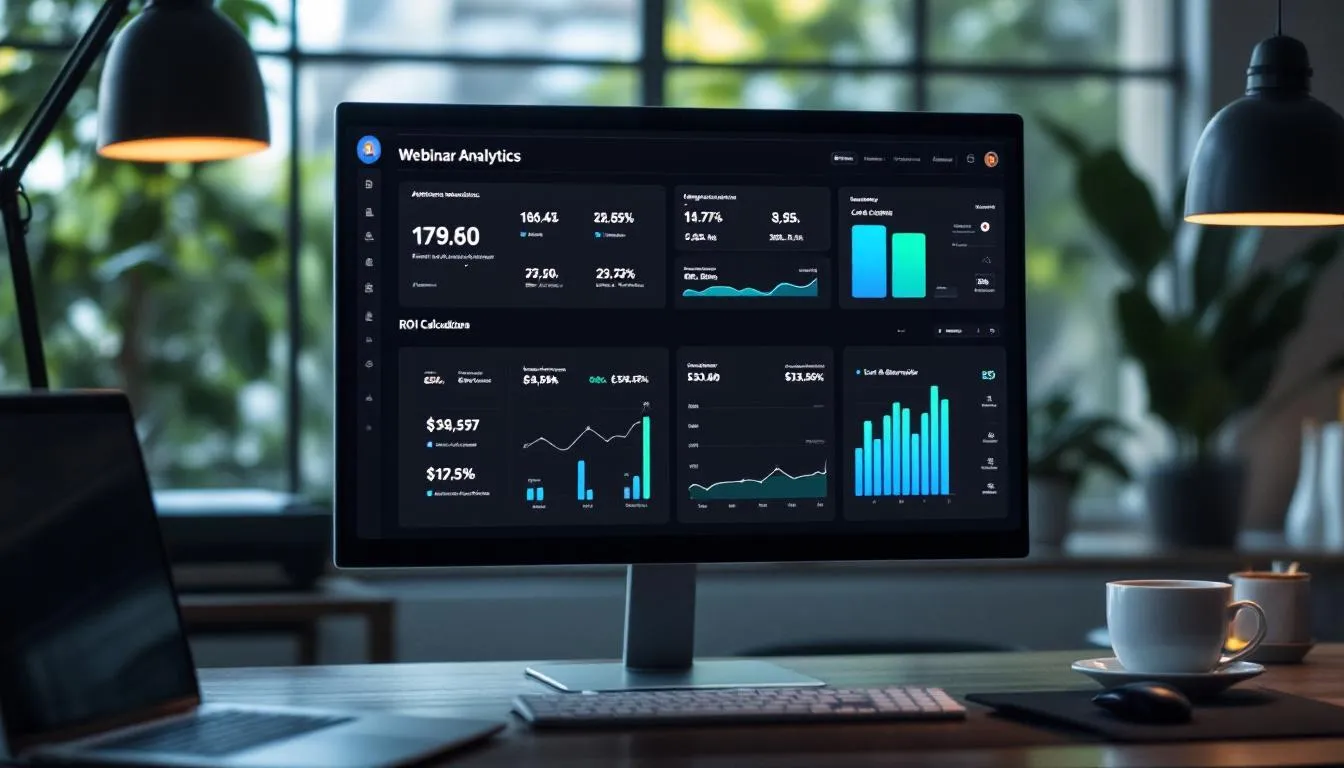Understanding Webinar Cost: Maximize Value While Minimizing Expenses
Learn how to effectively manage your webinar budget to maximize value and minimize costs. Discover practical tips to enhance your online events!

Understanding Webinar Cost: Maximize Value While Minimizing Expenses
Planning a webinar involves more financial considerations than most organizers initially realize. While the promise of virtual events suggests cost savings compared to in-person gatherings, the reality encompasses multiple expense categories that can significantly impact your budget and overall return on investment.
Understanding webinar cost requires looking beyond simple platform subscription fees to encompass equipment, marketing, staffing, and often overlooked additional expenses. Basic webinar platforms typically start at around $20–$50 per month, making them accessible for smaller-scale events. Whether you’re hosting your first virtual event or scaling an existing webinar program, having a comprehensive view of all associated costs enables better planning and more accurate ROI calculations.
This complete breakdown examines every aspect of webinar hosting expenses, from basic equipment needs to enterprise-level platform features, helping you make informed decisions that align with your goals and budget constraints.
Average Webinar Cost Overview
The average webinar hosting cost ranges from $3,000 to $5,000 per event when factoring in all associated expenses. However, this figure varies dramatically based on several key factors that directly influence your total investment.
Basic webinars can start as low as $500 with minimal features, utilizing free or low-cost webinar platforms and existing equipment. These budget-friendly options work well for small audiences and simple presentations but may lack the engagement tools and professional polish needed for lead generation or thought leadership initiatives.
Enterprise-level webinars with advanced features can exceed $10,000, especially when incorporating custom branding, professional production equipment, guest speaker fees, and comprehensive marketing campaigns. Large-scale virtual events targeting thousands of webinar attendees often require substantial investments in platform capabilities and technical support.

The cost variation depends primarily on:
-
Webinar type and complexity
-
Expected audience size and engagement requirements
-
Platform feature needs and integration requirements
-
Marketing scope and promotional budget allocation
Webinar Platform and Software Costs
Webinar software represents the foundation of your hosting costs, with pricing models varying significantly between providers. Many webinar platforms charge extra for advanced features like cloud storage or HD video streaming. Most webinar platforms offer tiered subscription plans based on attendee capacity and feature access, though pay-per-event options exist for occasional hosts.
Free platforms provide limited functionality, typically supporting 20-100 attendees with basic features and time restrictions. Free or limited-use platforms often restrict functionality, limiting the effectiveness of webinars for serious marketing efforts. While services like Livestorm offer free plans for up to 30 attendees, these come with significant limitations including 20-minute session caps and reduced functionality that may impact the professional quality of your webinar experience.
Paid platforms range from $42-$340/month depending on attendee capacity and features. Zoom webinars pricing starts at $79/month for 500 attendees, scaling to $340/month for 1,000 attendees. This webinar hosting platform provides reliable infrastructure with advanced features like detailed analytics dashboards, custom branding options, and comprehensive engagement tools.
WebinarNinja offers $49/month for basic plans with bundled features including automated webinar capabilities, email marketing integration, and interactive tools. This represents good value for users seeking an all-in-one solution without requiring separate marketing tools or additional integrations.
Livestorm provides $79/month plans with unlimited team members and advanced engagement tools, making it attractive for organizations requiring collaborative webinar hosting capabilities. The platform emphasizes user experience and includes breakout rooms, interactive polls, and seamless registration page creation.
Pay-per-webinar models charge $50-$200 per event for occasional hosts who prefer avoiding monthly subscription commitments. This approach works well for businesses hosting multiple webinars irregularly or testing webinar marketing before committing to recurring costs.
Enterprise custom pricing varies based on specific needs and integrations, often requiring quotes for organizations with complex requirements. These solutions typically include white-labeling, advanced CRM integrations, and dedicated technical support to ensure successful webinar execution.
| Platform Type | Monthly Cost | Attendee Limit | Key Features |
|---|---|---|---|
| Free Plans | $0 | 20-100 | Basic features, time limits |
| Entry Level | $42-79 | 100-500 | Standard tools, recordings |
| Professional | $79-199 | 500-1,000 | Advanced features, branding |
| Enterprise | $340+ | 1,000+ | Custom integrations, support |
Equipment and Production Costs
Quality webinar equipment significantly impacts audience engagement and professional credibility. Recording a high-quality video requires good-quality equipment such as webcams and microphones. While basic equipment can produce acceptable results, investing in better audio and video quality often correlates with higher attendee retention and more positive feedback.
USB microphones range from $45-$150, with options like the Blue Snowball iCE providing adequate audio quality for budget-conscious hosts, while the Blue Yeti offers professional-grade sound that enhances the overall webinar experience. Audio quality remains the most critical technical factor for audience satisfaction, making microphone investment a priority.
HD webcams cost $25-$70, from the Logitech C615 for basic needs to the C920 Pro for superior video quality. High quality webinars require consistent video performance, and investing in reliable equipment reduces technical issues during live presentations.
Lighting equipment adds $30-$100 for ring lights and basic setup components. Proper lighting dramatically improves video quality without requiring expensive cameras, making it a cost-effective upgrade for webinar hosts seeking professional appearance.
Computer requirements vary from $300-$1,037, depending on processing needs. A Dell Inspiron may suffice for basic webinars, while resource-intensive presentations or multiple simultaneous streams might require a Lenovo ThinkPad X1 or similar high-performance machine.
Video editing software costs approximately $20/month for content repurposing capabilities. This enables creating webinar recordings into multiple formats for extended content marketing value and social media promotion.
The total equipment investment typically ranges $400-$1,300 for a quality setup that produces impactful webinars. While this represents upfront costs, quality equipment serves multiple webinars and often pays for itself through improved audience engagement and professional credibility.

Marketing and Promotion Costs
Webinar promotion costs encompass various channels and tools needed to attract and register your target audience. Effective marketing often determines webinar success more than platform features or content quality, making promotion budget allocation crucial for achieving attendance goals.
Email marketing tools cost around $15/month through services like ConvertKit or Mailchimp, with free plans available for smaller lists. These platforms enable automated registration confirmation sequences, reminder campaigns, and post-event follow-up that maximizes webinar value and lead generation potential.
Paid advertising campaigns typically require $200-$500 per campaign across Google, Facebook, and LinkedIn platforms. The more effort you put into targeted marketing, the higher the number of attendees you'll gain. Social media promotion costs vary significantly based on audience targeting, competition levels, and campaign duration. LinkedIn advertising often costs more but provides better B2B audience targeting for professional webinars.
Landing page builders cost $12.95/month through services like Canva, though many webinar platforms include built-in registration page functionality. Using built-in landing pages instead of paid tools can save money without affecting conversion rates. Custom landing pages often improve conversion rates but represent additional monthly expenses that should factor into your webinar budget calculations.
Social media promotion offers free organic reach potential versus paid social ads requiring ongoing investment. Organic promotion strategies can be as effective as paid ads for driving attendance to webinars. Building an engaged social following takes time but provides sustainable, low-cost promotion for recurring webinars and multiple events.
Influencer partnerships vary based on collaboration terms and can range from content exchange agreements to substantial fee arrangements. Industry experts may charge speaker fees while providing promotional value through their established audiences.
Content creation tools range $4.92-$30/month for services like Prezi or Keynote templates that enhance presentation visual appeal. While not mandatory, professional presentation design often improves audience engagement and perception of webinar value.
Guest Speaker and Staffing Costs
Guest speaker fees add significant value to webinars while representing notable cost considerations. Industry experts typically charge $75-$200 for webinar appearances, bringing credibility and specialized knowledge that justifies the investment through improved attendance and audience engagement.
Popular influencers command higher fees ranging from $500-$5,000+ depending on their audience size and industry recognition. While expensive, influential guest speakers can dramatically expand webinar reach and establish thought leadership positioning for your organization.
Technical support staff costs $50-$100/hour for large events requiring dedicated assistance. Complex webinars or those expecting high attendance often benefit from professional technical support to handle registration issues, troubleshoot participant problems, and ensure smooth execution.
Content creation teams require variable investment based on in-house versus outsourced approaches. Professional content development, slide design, and interactive element creation can add substantial costs but often improve webinar quality and audience retention significantly.
Moderator or co-host fees range $25-$75/hour for professional support during webinar delivery. Experienced moderators can manage audience engagement, handle Q&A sessions, and provide backup presentation support that reduces host stress and improves overall execution.

Training existing team members often provides more cost-effective alternatives to external staffing while building internal capabilities for future webinars. Investing time in team webinar training reduces ongoing staffing costs and creates more flexibility for hosting multiple webinars regularly.
Additional Hidden Costs
Hidden costs frequently surprise webinar organizers and can significantly impact total expenses. These can include overage charges for exceeding attendee limits or needing extra cloud storage. Understanding these potential additional costs enables better budget planning and prevents unexpected financial strain during webinar execution.
Overage fees occur when exceeding attendee limits on your chosen webinar plan. Most webinar platforms charge substantial penalties for additional participants, making accurate attendance estimation crucial for cost control. Some platforms offer automatic upgrades while others restrict access, potentially damaging webinar reputation.
Cloud storage represents ongoing costs for webinar recordings beyond free storage limits provided by your webinar hosting platform. Extended storage for multiple sessions or high-definition recordings can add $10-$50/month depending on volume and retention requirements.
Custom branding services cost $100-$500 for white-labeling and professional design elements that remove platform branding and create cohesive visual experiences. While not essential, custom branding significantly improves professional appearance and reinforces organizational identity.
Integration fees apply when connecting webinar platforms with CRM systems, marketing automation tools, or analytics platforms. Some integrations require premium plan upgrades or third-party connector services that add monthly subscription costs to your webinar budget.
Multiple hosts or co-presenters may trigger additional charges depending on platform pricing models. Some services charge per additional host while others include multiple presenters in base plans, making platform selection important for collaborative presentations.
Extended session duration beyond plan limits often incurs hourly fees or requires plan upgrades. Planning realistic session lengths and including buffer time helps avoid unexpected charges during important presentations.
Cost Breakdown by Webinar Type
Different webinar formats require varying investment levels and ongoing cost structures. Understanding these differences helps optimize spending based on your specific goals and audience engagement requirements.
Live webinars incur higher ongoing costs with real-time hosting requirements, technical support needs, and active moderation demands. However, they provide maximum audience engagement through real-time interaction, Q&A sessions, and immediate feedback that often justifies increased investment.
Automated or evergreen webinars require higher upfront production costs but lower long-term expenses once created. Pre recorded webinars can serve unlimited audiences without additional hosting costs, making them cost-effective for evergreen content and ongoing lead generation campaigns.
Hybrid events combine in-person and virtual elements, requiring additional costs for video streaming equipment, venue coordination, and dual-audience management. While more expensive, hybrid events maximize reach and accommodate diverse attendance preferences.
Training webinars typically involve moderate costs with significant potential for content reuse across multiple sessions. Educational content often has longer shelf life, enabling organizations to amortize production costs across numerous training events and employee education programs.
Product demonstrations require variable costs based on complexity and interactivity needs. Simple screen sharing demonstrations cost less than elaborate interactive product tours requiring specialized software and advanced engagement features.
How to Reduce Webinar Costs
Strategic cost management enables organizations to host multiple webinars while maintaining quality and maximizing return on investment. Several proven approaches can significantly reduce expenses without compromising webinar effectiveness.
Choose appropriate pricing models by comparing pay-per-event versus subscription costs based on your hosting frequency. Organizations planning multiple webinars annually often save money with monthly subscription plans, while occasional hosts benefit from pay-per-event pricing that avoids ongoing commitment.
Use built-in platform features instead of third-party tools whenever possible. Many webinar platforms include email marketing, landing page creation, and basic analytics that eliminate needs for separate service subscriptions and reduce integration complexity.
Leverage free marketing channels through organic social media promotion and existing email lists rather than relying solely on paid advertising. Building authentic audience relationships provides sustainable, low-cost promotion for recurring webinars and reduces dependence on paid campaigns.
Repurpose webinar content by creating multiple formats from single webinar recordings. Transform presentations into blog posts, social media content, podcast episodes, and educational courses that extend value far beyond the initial live event.
Start with basic equipment and upgrade gradually as webinar revenue increases. Quality USB microphones and adequate lighting provide substantial improvement over built-in computer equipment without requiring major upfront investment.
Minimize staffing costs by training existing team members rather than hiring external support. Developing internal webinar capabilities creates long-term cost savings and provides greater flexibility for hosting multiple webinars regularly.
Avoid overage fees by carefully monitoring registration limits and using social media streaming as backup options for overflow audiences. Planning realistic capacity and having contingency plans prevents expensive last-minute platform upgrades.
Webinar ROI and Cost-Effectiveness
Understanding webinar return on investment helps justify expenses and optimize spending for maximum impact. Properly executed webinars typically generate substantial returns that far exceed total costs when factoring in lead generation, sales acceleration, and brand building benefits.
ROI calculation follows the formula: (Total Gains - Total Cost) / Total Cost × 100. This straightforward metric enables comparison with other marketing initiatives and helps justify webinar budget allocation within broader marketing strategies.
Average webinar ROI exceeds 300% with proper execution and follow-up campaigns. Successful webinars generate qualified leads, accelerate sales cycles, and establish thought leadership that provides ongoing value beyond immediate registration and attendance metrics.
Lead generation value often provides 15X lower cost per lead than traditional marketing approaches. Webinars enable direct audience engagement, immediate qualification, and detailed attendee information that facilitates personalized follow-up and nurturing campaigns. They are key lead generators and an excellent way to promote your brand online.
Long-term benefits include enhanced brand authority, improved customer trust, and ongoing lead nurturing opportunities that compound initial investment returns. Educational webinars particularly establish expertise positioning that influences future purchasing decisions and referral generation.
Content repurposing extends value through social media clips, blog post creation, podcast episodes, and online course development. Single webinars can generate months of additional content marketing materials that amplify initial investment returns significantly.
Comparison to alternatives demonstrates superior cost-effectiveness versus trade shows, in-person events, and traditional advertising approaches. Virtual events eliminate travel costs, venue expenses, and geographical limitations while providing detailed analytics and follow-up capabilities.

Budget Planning and Allocation
Effective webinar budget allocation ensures optimal resource distribution across all necessary components while maintaining flexibility for unexpected costs. Following proven allocation frameworks helps maximize impact while controlling expenses.
Allocate 40% of your webinar budget for platform and hosting costs, including subscription fees, overage protection, and basic technical support. This represents the foundation expense that enables webinar delivery and should account for growth in attendee capacity.
Reserve 25% for marketing and promotion expenses, covering paid advertising, email marketing tools, content creation, and promotional materials. Effective promotion often determines webinar success more than platform features, making adequate marketing investment crucial.
Budget 20% for equipment and production quality improvements, including microphones, cameras, lighting, and presentation design tools. Quality production values significantly impact audience perception and engagement levels throughout the webinar experience.
Set aside 10% for guest speakers and additional staffing needs, including expert fees, technical support, and content creation assistance. Professional support often improves webinar quality while reducing host stress and technical difficulties.
Keep 5% buffer for unexpected costs and platform overages, providing flexibility for registration surprises, technical issues, or last-minute enhancement needs. This contingency helps prevent budget overruns and enables rapid problem resolution.
| Budget Category | Allocation | Example ($3,000) | Key Components |
|---|---|---|---|
| Platform/Hosting | 40% | $1,200 | Subscription, overages, support |
| Marketing | 25% | $750 | Ads, email tools, content |
| Equipment | 20% | $600 | Audio, video, lighting |
| Staffing | 10% | $300 | Speakers, technical support |
| Contingency | 5% | $150 | Unexpected costs, overages |
Budget planning should account for webinar frequency and scaling requirements. Organizations planning recurring webinars benefit from annual billing discounts and equipment amortization across multiple events, while occasional hosts should focus on variable cost minimization.
Consider total cost of ownership including setup time, training requirements, and ongoing maintenance when comparing platform options. Sometimes higher monthly fees provide better overall value through included features, support quality, and ease of use that reduces hidden time investments.
Regular budget review and adjustment based on actual performance helps optimize spending and identify cost reduction opportunities. Track metrics like cost per attendee, cost per lead generated, and overall ROI to guide future budget allocation decisions and platform selection.
Understanding comprehensive webinar cost enables informed decision-making that balances quality, reach, and financial efficiency. While initial investments may seem substantial, properly planned webinars consistently deliver returns that justify expenses while building valuable audience relationships and establishing market authority. Start with realistic budget allocation, focus on essential quality elements, and scale investment based on proven results to build sustainable, cost-effective webinar programs.